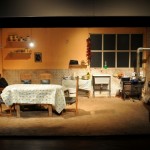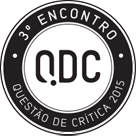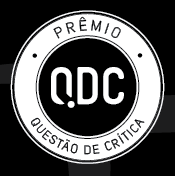With a match – Theatrical interventions in history
A review of Galvarino and Derretiré con un cerrillo la nieve de un volcán
Vol. IX, nº 67 abril de 2016 :: Download complete edition in PDF
By Daniele Avila Small
Translated by Cláudia Cruz
Summary: The purpose of the present article is to make a brief analysis of the plays Galvarino, by the Chilean group Teatro Kimen, and Derretiré con un cerrillo la nieve de un volcán, by the Mexican Group Lagartijas Tiradas al Sol, using the concept of documentary theatre as a starting point. The analysis carried out here discusses the connection between contemporary documentary theatre and history, and opens up a discussion on whether this theatre genre could make a cognitive contribution to the transmission of historical knowledge.
Key words: Documentary theatre, Latin-American theatre, historiography, fiction and history, document.
Published in Portuguese in December, 2014 at Questão de Crítica. Available at: http://www.questaodecritica.com.br/2014/12/com-um-palito-de-fosforo-intervencoes-teatrais-na-escrita-da-historia/
In order to talk about documentary theatre, we must acknowledge that this is quite a complex category nowadays. Current practices are considerably different from those that consolidated the genre in the history of theatre, from Piscator to the last decades of the twentieth century. It is up to us, those who study contemporary theatre, to elaborate, in the near future, an up-to-date definition of the genre from recent works that seem to belong to it. Contemporary practices distance themselves from a traditional idea of documentary theatre, but do not entirely detach from it, and as a result, they broaden the category.
The Argentinian writer-director Lola Arias, who created plays such as Mi vida después, does not seem very comfortable with the idea of having her work listed as documentary theatre since she considers it “an old category”. However, it is due to the relevance of recent works that documentary theatre can no longer be considered “an old category”, and has become a pertinent up-to-date practice.
According to the book edited by the French critic and academic Jean-Pierre Sarrazac, Lexique du drame moderne et contemporain, documentary theatre “lies on the dialectical tension of fragmentary elements directly extracted from political reality. However, unlike the naturalistic project, it does not aspire to faithfully reproduce a fragment of reality, but to submit historical and current events to a structural explanation, resorting to radical formalization in order to achieve such an aim.” (SARRAZAC, 2012, p. 182)
This view on the subject, however, only corresponds to 20th century’s documentary theatre, when political history was a dominant theme for the genre. The entry in the book concludes with the following suggestion:
“In the future, there might exist a documentary theatre of the individual, the existential, of symbols or feelings, which will contradict its predecessors.” (SARRAZAC, 2012, p. 183)
A few experiments in documentary theatre carried out in Latin America in the beginning of the 21st century, like the ones that will be discussed here, point exactly to the type of theatre that “will contradict its predecessors”. Nevertheless, it does not represent an actual contradiction. The documentary theatre we are trying to envision does not separate the political from the existential or from feelings. The change here is almost a matter of emphasis.
Two plays that took part in the 9th Latin-American Theatre Festival, organized by the Paulista Cooperative Theatre Group[1] in São Paulo in August 2014, will be analyzed here using the questions proposed above as a starting point.
Galvarino, by the Chilean group Teatro Kimen, talks about Galvarino Ancamil’s disappearance and death. Galvarino was a political activist who voluntarily exiled in Russia in the 1970s after the military coup in Chile. After the downfall of the communist regime, Galvarino’s family never heard from him again. His sister, Marisol Ancamil, went through a long and tortuous process to get information about him. At first, she begged the Foreign Ministry to locate her brother, assuming he might be killed. Later, she pleaded with the government to retrieve Galvarino’s remains. But her appeals were to no avail. Galvarino, a foreigner from South America with indigenous background, was executed by a neo-Nazi group in Moscow, in 1993. Had the Chilean government devoted any attention to Marisol’s letters, Galvarino might have been located and brought safely back home.
Galvarino is part of a trilogy that belongs to the documentary theatre genre – the other plays are Ni pu tremem – Mis antepassados, from 2008, and Territorio descuajado – Testimonio de un pais mestizo, from 2010. As they say in the introduction to the project available on YouTube, the trilogy consists of:
“Three stagings, three different scenic/territorial languages, three marginal accounts that raise questions about the documentary genre, due to its immense ability to capture entirely unknown aspects of the world around us, the closest, most familiar, and routine events.”[2]
The poetics of Galvarino lies on the construction of a fictitious cosmos that creates a naturalistic atmosphere, permeated by an epic language aimed at the audience. In addition, there are the letters exchanged with government organs and the Mapuche ritualistic chants in its full performative force. The scenery shows the house of Galvarino’s family, where his sister, his mother, and his father expect news about him while preparing a meal. The waiting time heavily imposes itself from the very beginning of the play. There are long silences when the mother literally plucks a chicken and the father fixes an object while listening to the radio. After some time, Galvarino’s sister starts reading the letters she wrote to the government and the replies she received from them, while they are projected on the back wall of the stage. She is standing in front of us, facing us, talking to us.
In São Paulo, Paula Gonzales Seguel, Marisol’s niece and the director the play, played Marisol Ancamil. Galvarino’s uncle, Luis Seguel, Paula’s father, played Galvarino’s father. The mother was played by Elsa Quinchaleo, who had no previous experience in the theatre until Paula started to gather women from the Mapuche ethnic group for her theatrical experimentation.
Derretiré con un cerrillo la nieve de un volcán (I will melt the snow off a volcano with a match) is a documentary theatre play from the group Lagartijas Tiradas al Sol, in which the artists investigate the origins and trajectory of the PRI – Partido Revolucionário Institucional (Institutional Revolutionary Party) – who was part of the Mexican government from 1929 to 2000. The party was restored to power in 2012 and their comeback prompted Lagartijas to tell Mexico’s political history from the point of view of their generation.
The title is a quote from Jorge Meixueiro, an Oaxacan politician who ran for federal deputy in 1943. In the speech he delivered in Congress after receiving the news of his defeat, he said, “Sé que picaré con un clavo una montaña o que derretiré con un cerillo la nieve de un volcán”[3] and then shot himself in the mouth. The artists then decided to take a stand and tell Mexico’s political history in a seemingly traditional way, passing on information, such as dates, names, facts, graphs, and statistical data. They also present concrete evidence, projecting documents on the back wall of the stage. Two things make this historical narrative different. Firstly, the staging. Theatrical resources, such as masks, placards, and posters with photographs, are used when the actors put themselves in the place of the historical characters, adding playful elements to the seriousness of the theme. Secondly, the play also makes cuts in this historiographical and linear narrative by sewing together, side by side, accounts of the political facts and details about the private life of the young Natalia Valdez Tejeda, a teacher, single mother, and militant in Mexico City. Natalia abandoned her family – who supported the PRI – and isolated herself in a small village in the countryside, where she wrote the book La Revolución Institucional. The book served as a guiding light to directors/actors Luisa Pardo and Gabino Rodriguez in the creation of the play. Therefore, while the historical events of public life are dealt with in a more traditional, historiographical way (in spite of its ludic approach), Natalia’s personal history – and whatever one may speculate about her subjectivity – is told with more creative freedom with the use of knowingly fictional techniques.
On stage, there are tables, chairs, and several plants – some in vases on the floor, others hanging from the ceiling. The objects used during the performance are already on stage, so that the actors do not have to leave the scene to get them. The set design does not copy any recognizable place. The actors occasionally move around the props and set up scenographic “stations”, i.e. temporary spaces for certain scenes.
The artistic procedures of the play were already present in a previous work from the group, El rumor del incendio, which I only saw on video (available for download on the website On the Boards TV[4] (4)). In this play, the group also chooses the story of a female character – Margarita Urías, a guerrilla fighter – to tell Mexico’s political resistance history in the 1960’s and 1970’s. At the end of the play, we find out Margarita is Luisa Pardo’s mother. Luisa co-wrote and co-directed the play, and interprets her mother’s role.
The sliding movement in Lagartijas’ plays between the official history and micro-history, between articles published in major newspapers and personal letters and diaries, creates a game between the different scales in the historical discourse, and we must keep on adjusting our lenses, quickly zooming in and out. Little by little, the oscillation (positively) confounds us and makes us stop paying too much attention to the frame.
I would like to point out an interesting aspect of contemporary documentary theatre in the above examples: the complexity of the work of actors as their bodies become a vital part of the scenic design. The actor can both deliver the lines, i.e. the spoken discourse, and become an evidence of the story that is being told. The presence of the actress/director’s body, Paula Gonzales Seguel, and her father’s, Luis Seguel, who are on stage to tell a family story, authenticate the testimony and effectively bring history to the present. The same thing occurs with Luisa Pardo’s presence in El rumor del incendio.
In another review[5] (5) I wrote, about the play Mi vida después, I resorted to an article written by Spanish academic Oscar Cornago on the auratic dimension of the present body that functions as a witness. Therefore, I will not explore the subject here, although Paula and Luis’s example in Galvarino, as well as Luisa’s in El rumor eloquently reinforce the argument presented there. The body on stage is a scenic body that offers itself as a document of reality and makes the frames of theatricality and historiography dance together.
It is a historian-body, a body that writes, rewrites, takes up a place, a body that is no longer anonymous, that announces itself, that makes a stand and takes responsibility for the narrative. Paula takes over as her aunt’s voice; first, conceiving the work/play, later, playing her role.
The idea of presence implies yet another layer of the artists’ testimony, one that goes beyond the strict sense of an account, a testimony, or a document: the artists’ presence on stage as actors, agents, and not characters in a fictional game, whose presence is closely related to an expression of their thought, a materialization of their conduct as artists. And more important than all the demands of the actors’ craft is that we see, right there in front of us, artists who come forward exposing their political and aesthetic choices. The artists themselves are as evident as the story they tell. The foundations for their work is clearly based on an authorial project.
In addition, some characters are paradigms of the stories being told on stage. Marisol, Natalia, and Margarita are women – as are Paula and Luisa, who created the projects. All of them talk from a marginal place, be it the Mapuche family in Chile or the guerrilla militancy in Mexico. Although we are in the 21st century, women have not fully gained the ownership of their bodies yet – not even by the law, as can easily be seen around us. With that in mind, we can consider the document-bodies of these creator-witnesses a remarkably coherent voice.
The cognitive contribution from documentary theatre to history
If we think about Lagartijas’ choice to tell Natalia’s story in parallel with Mexico’s history and PRI’s project to assume power, we notice that to a certain extent documentary theatre can also be seen as a composition that confronts the official ways of historical discourse. In her article entitled Teatro documental: el referente como inductor de lectura, the Uruguaian academic Silka Freire considers the existence of:
“(…) a non-traditional discourse construction, whose starting point is an identical referent in its ontological categorization. However, its objective is the pluralization of its own meaning through a rupture in the dominant discourse structure. Also, it does not intend to replace it, but to induce a confrontation through the establishment of new channels of understanding that allow for the elaboration of a new field of meaning.” (2006, p. 6)
Derretiré presents itself as a political act. It takes a stand before the need to review recent historical narratives; to take a fresh look at facts, situations, and institutions; and to propose attributing new meanings to them, taking full responsibility for historical narratives. The political gesture of documentary theatre is to redistribute a few cards and suggest a different framework for historical discourse, as we see in Galvarino. There we become acquainted with a part of Chile’s history from a point of view that would not be visible through the country’s official history. I believe that in Kimen’s and Lagartijas’ plays, the artists are claiming a different kind of authority – or, as it says in the above quote, they are trying to establish “new channels of understanding”. Now we have come to a crucial issue for this critical exercise.
Considering the fact that documentary theatre provides an opportunity for fictional and historiographic discourses to coexist, which questions may we ask the theory of history about the coexistence of both utterances? How can theatre be an operational tool – one that problematizes the issues at stake – of a specific historical discourse? The fact itself, taken from real life, is the starting point for both the creation of documentary theatre and the writing of history, as well as for the historiographical and the fictional approaches. Documentary theatre is a problematic place for this differentiation since it shuffles the discourses, thus inducing an intentional confusion in the way we deal with the narrative of reality.
The aporia of truth in the writing of history does not represent the end of it but rather its starting point, its possibility to exist. With that in mind, we suggest that the problematic place of the fictional element in documentary theatre should not invalidate its historiographical aspirations, but rather that it should represent a constitutive matter of its form, therefore, an object of study functioning as an utterance that transmits historical knowledge.
The relationship with the audience in documentary theatre is not the same as the relationship established by a solely historiographical text. Dramaturgy presupposes a special reading dynamics, an irreversible reading, since readers do not control the text, cannot manipulate the reading act as they do when reading a book, cannot go back as they please to check something up, nor can they detain themselves over a specific passage (unless they recollect what they saw during the performance). Even if they watch the play more than once, contact is established through the scene, not the reception. What spectators keep to themselves is more an experience than content. The atmosphere, the tone, the attitude – these are the elements that become evident and guide memory.
Aesthetic enjoyment is as determinant a premise as the account of the event – but that does not mean that the writing of history doesn’t rely on an elaboration of the material construction of the text, after all, it “stores within itself a portion of mimesis”, as states Luiz Costa Lima in his História.Ficção.Literatura (2006, p.208). However, it is the very coexistence of functions that intermediate the discourses and complicate the relationship between the spectator and the apprehension of a historical discourse through theatrical language. The pervious discursive borders heighten the spectators’ critical sense and their attention to the construction of discourse.
The oscillation between the accounts of reality and the theatrical techniques, between concrete evidence and personal accounts and the elaboration of fictional procedures, has the spectators constantly renegotiating their pact with theatre, their witnessing of reality and their reading of history, constantly retracing their thoughts about fictional narrative and the account of reality. Imagination works together with critical sense, attention, and distraction in a dynamic relationship.
To conclude this brief reflection – no doubt a temporary speculation –, we bring something new to the discussion, i.e. questions posed at the course entitled “History and Fiction”, taught by Prof. Felipe Charbel, in the second semester of 2014, as part of the History post-graduate programme at UFRJ (Federal University of Rio de Janeiro). “What would be the cognitive contribution from fiction to history? What comes out of such works as regards historical knowledge or the transmission of historical knowledge, in addition to the factual information they provide? What do these plays reveal about historical knowledge that is so special, or different?”
Here, we grope for an answer that relates to the observation made at the beginning of this text with the quote from Lexique du drame moderne et contemporain. What would be the nature of such contribution: individual, existential, symbolic, or feeling-related, as the author suggests about the future of documentary theatre? It may be the case that we suggest a more creative concept of knowledge. Perhaps, the fundamental issue is not “what”, but “how”; not which historical knowledge, but how to deal with historical knowledge. At this point, we call attention to the necessary presence of imagination as a wider space for speculation about the very notion of historical knowledge.
Moreover, in my opinion, the historical knowledge provided by these plays is not just in the information they provide, neither is it in the curiosity they may arouse, but in the connection that may be established. The presence of bodies, the use of the first person singular, the ludic element, the characteristic orality of theatre, the coexistence in the shared space-time of performance, the actress who undresses in Derretiré, the ritual chanting in Galvarino, these are elements that evoke feelings, physical sensations that connect us, spectators, with what the artists are telling us. They are little sparks that strengthen the creation of an improbable feeling of belonging between audiences from around the world (for those plays that are performed in different countries) and marginalized realities in distant territories.
But what does contemporary theatre mean to the theory of history? What is the role of a theatrical work of art, an ephemeral moment with craft production methods, in this vast territory of academic activities and history books? How can we calculate the value of an exchange between contemporary documentary theatre made in Latin America and current research about the theory of history? The only way I can think of is to visualize a match before the snow of a volcano.
Bibliographical references:
COSTA LIMA, Luiz. História. Ficção. Literatura. São Paulo: Companhia das Letras, 2006.
FREIRE, SILKA. “Teatro documental: el referente como inductor de lectura”. In: Telondefondo Revista de teoría y crítica teatral.Nº 4 Diciembre 2006. Available at: http://www.telondefondo.org/numeros-anteriores/numero4/articulo/60/teatro-documental-el-referente-como-inductor-de-lectura.html
SARRAZAC, Jean-Pierre (org). Léxico do drama moderno e contemporâneo. Translated by André Telles. São Paulo: Cosac Naify, 2012.
SMALL, Daniele Avila. Atos físicos da memória, re-inscrições na História – Mi vida después review, by Lola Arias in Questão de Crítica – revista eletrônica de críticas e estudos teatrais. Vol. III, nº 26, October 2010. Available at: http://www.questaodecritica.com.br/2010/10/atos-fisicos-da-memoria-re-inscricoes-na-historia/
TEJEDA, Natalia Valdéz. La revolución institucional. Mexico City: Editores Independentes de Alvarado, 2000.
Daniele Avila Small is a PhD student in Performing Arts at the Universidade Federal do Estado do Rio de Janeiro (Federal University of the State of Rio de Janeiro / UniRio). She holds a Master’s Degree in the Social History of Culture from PUC-Rio and a Bachelor’s Degree in Theatre Theory from UniRio. She is author of O crítico ignorante – uma negociação teórica meio complicada (7Letras, 2015), and the editor and founder of the electronic magazine Questão de Crítica.
English translation by Cláudia S. Cruz. Cláudia has a Master’s degree in Performing Arts from UNIRIO, and two postgraduate degrees – English and Screenplay Writing and Drama. She has been a translator since 1992, having translated books, articles, materials for exhibitions, plays, screenplays, among other types of texts. She has taken part in International Translation Congresses, where she presented her research on Drama Translation.
Notes:
[1] DocumentaCena is a platform constituted by the website Teatrojornal, from São Paulo; the blogs Horizonte da Cena, from Belo Horizonte, and Satisfeita, Yolanda?, from Recife; and the electronic magazine Questão de Crítica, from Rio de Janeiro.
[2] Tres puestas en escena, tres lenguajes escénicos-territoriales, tres relatos marginales, que indagan sobre el género documental por su inmensa capacidad de capturar aspectos absolutamente desconocidos de la realidad que nos circunda; la más cercana, familiar y cotidiana. https://www.youtube.com/watch?v=Y38nDuRD5VQ
[3] I know I will chip a mountain with a nail or melt the snow off a volcano with a match”, in a free translation.
[4] On The Boards TV http://www.ontheboards.tv/performance/theater/el-rumor#about
[5] See SMALL, Daniele Avila. Atos físicos da memória, re-inscrições na História – Review of Mi vida después, by Lola Arias in Questão de Crítica Vol. III, nº 26, October 2010. Available on: http://www.questaodecritica.com.br/2010/10/atos-fisicos-da-memoria-re-inscricoes-na-historia/










